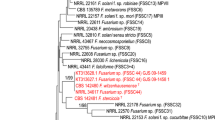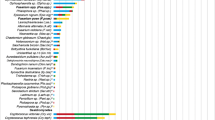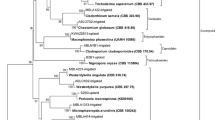Abstract
Fusarium equiseti is prevalent in ginseng soil, straw mulch and in ginseng root tissues and is the cause of a root surface discolouration on ginseng grown in British Columbia. Population levels of the fungus in ginseng fields ranged from 3.8 × 103 cfu g−1 soil to 1.4 × 104 cfu g−1 soil and were highest at 0–5 cm soil depths compared to 10–15 cm. Soil population levels were negatively correlated with S content in soil and positively correlated with Zn levels. Barley or wheat straw added to soil significantly increased population levels under laboratory conditions. Mycelial growth in culture was highest at 26–30°C and at pH 7.2–7.8. Samples of flowers and berries, and harvested seed, contained DNA of F. equiseti detected using a Fusarium-specific DNA array and the fungus was isolated from these tissues on agar medium. A high degree of genetic variation in the EF-1 alpha gene sequence was present among 52 isolates of F. equiseti which originated from ginseng fields. At least seven clades were identified. Inoculum dispersal from straw mulch used in ginseng gardens can result in seed contamination by the fungus. In addition, fungal growth near the soil surface under warm summer conditions can result in infection and crown discolouration of ginseng roots.






Similar content being viewed by others
References
Adams, G. C., Gubler, W. D., & Grogan, R. G. (1987). Seedling disease of muskmelon and mixed melons in California caused by Fusarium equiseti. Plant Disease, 71(4), 370–374.
Aigbe, S. O., & Fawole, B. (1999). A cowpea seed rot disease caused by Fusarium equiseti identified in Nigeria. Plant Disease, 83, 964.
Barasubiye, T., Seifert, K., Tenuta, A., Rioux, S., Anderson, T., Welacky, T., et al. (2005). Monitoring of Fusarium species in soybean roots by DNA array hybridization. Phytopathology, 95, S59.
Bottalico, A. (1998). Fusarium diseases of cereals: species complex and related mycotoxin profiles, in Europe. Journal of Plant Pathology, 80, 85–103.
Brammall, R. A. (1994). Ginseng. In R. J. Howard, A. J. Garland, & W. L. Seaman (Eds.) Diseases and pests of vegetable crops in Canada (pp. 194–199). Ottawa, ON: Canadian Phytopathological Society and Entomological Society of Canada.
Chimbekujwo, I. B. (2000). Frequency and pathogenicity of fusarium wilts (Fusarium solani and Fusarium equiseti) of cotton (Gossypium hirsutum) in Adamawa in Nigeria. Revista de Biologia Tropical, 48, 1–5.
Demirci, E., & Dane, E. (2003). Identification and pathogenicity of Fusarium spp. from stem bases of winter wheat in Erzurum, Turkey. Phytoparasitica, 31(2), 170–173.
Dill-Macky, R., & Jones, R. K. (2000). The effect of previous crop residues and tillage on Fusarium head blight of wheat. Plant Disease, 84(1), 71–76.
Fedel-Moen, R., & Harris, J. R. (1987). Stratified distribution of Fusarium and Bipolaris on wheat and barley with dryland root rot in South Australia. Plant Pathology, 36, 447–454.
Gale, L. R. (2003). Population biology of Fusarium species causing head blight of grain crops. In K. J. Leonard, & W. R. Bushnell (Eds.) Fusarium head blight of wheat and barley (pp. 120–143). St. Paul, MN: The American Phytopathological Society.
Hestbjerg, H., Nielsen, K. F., Thrane, U., & Elmholt, S. (2002). Production of trichothecenes and other secondary metabolites by Fusarium culmorum and Fusarium equiseti on common laboratory media and soil organic matter agar: An ecological interpretation. Journal of Agricultural and Food Chemistry, 50(26), 7593–7599.
Inch, S., & Gilbert, J. (2003). The incidence of Fusarium species recovered from inflorescences of wild grasses in southern Manitoba. Canadian Journal of Plant Pathology, 25, 379–383.
Ioos, R., Belhadj, A., Menez, M., & Faure, A. (2005). The effects of fungicides on Fusarium spp. and Microdochium nivale and their associated trichothecene mycotoxins in French naturally-infected cereal grains. Crop Protection, 24(10), 894–902.
Komada, H. (1975). Development of a selective medium for quantitative isolation of Fusarium oxysporum from natural soil. Review of Plant Protection Research, 8, 114–125.
Kosiak, E. B., Holst-Jensen, A., Rundberget, T., Jaen, M. T. G., & Torp, M. (2005). Morphological, chemical and molecular differentiation of Fusarium equiseti isolated from Norwegian cereals. International Journal of Food Microbiology, 99(2), 195–206.
Logrieco, A., Bottalico, A., Mule, G., Moretti, A., & Perrone, G. (2003). Epidemiology of toxigenic fungi and their associated mycotoxins for some Mediterranean crops. European Journal of Plant Pathology, 109(7), 645–667.
Martinez, C., Michaud, M., Belanger, R. R., & Tweddel, R. J. (2002). Identification of soils suppressive against Helminthosporium solani, the causal agent of potato silver scurf. Soil Biology and Biochemistry, 34, 1861–1868.
Mesterhazy, A. (2003). Control of Fusarium head blight of wheat by fungicides. In K. J. Leonard, & W. R. Bushnell (Eds.) Fusarium head blight of wheat and barley (pp. 363–380). St. Paul, MN: The American Phytopathological Society.
Nash, S. M., & Snyder, W. C. (1965). Quantitative and qualitative comparisons of Fusarium populations in cultivated fields and noncultivated parent soils. Canadian Journal of Botany, 43(8), 939–945.
Parry, D. W., Jenkinson, P., & McLeod, L. (1995). Fusarium ear blight (scab) in small-grain cereals – a review. Plant Pathology, 44(2), 207–238.
Pereyra, S. A., Dill-Macky, R., & Sims, A. L. (2004). Survival and inoculum production of Gibberella zeae in wheat residue. Plant Disease, 88(7), 724–730.
Punja, Z. K. (1997). Fungal pathogens of American ginseng (Panax quinquefolius L.) in British Columbia. Canadian Journal of Plant Pathology, 19, 301–306.
Punja, Z. K., Wan, A., Goswami, R. S., Verma, N., Rahman, M., Barasubiye, T., Seifert, K. A. and Levesque, C. A. (2008). Diversity of Fusarium species associated with discolored ginseng roots in British Columbia. Canadian Jounal of Plant Pathology (in press).
Rai, R. P. (1979). Fusarium equiseti (Corda) Sacc. causing dry rot of potato tubers – New report. Current Science, 48(23), 1043–1045.
Reuveni, R. (1982). Fusarium equiseti – A new cause of cumin spice plant wilt in Israel. Plant Disease, 66(6), 498–499.
Sangalang, A. E., Backhouse, D., & Burgess, L. W. (1995a). Survival and growth in culture of 4 Fusarium species in relation to occurrence in soils from hot climatic regions. Mycological Research, 99, 529–533.
Sangalang, A. E., Burgess, L. W., Backhouse, D., Duff, J., & Wurst, M. (1995b). Mycogeography of Fusarium species in soils from tropical, arid and mediterranean regions of Australia. Mycological Research, 99, 523–528.
Schluter, C., & Punja, Z. K. (2000). Floral biology and seed production in cultivated North American ginseng (Panax quinequefolius). Journal of the American Society for Horticultural Science, 125(5), 567–575.
Shaner, G. (2003). Epidemiology of Fusarium head blight of small grain cereals in North America. In K. J. Leonard, & W. R. Bushnell (Eds.) Fusarium head blight of wheat and barley (pp. 84–119). St. Paul, MN: The American Phytopathological Society.
Strausbaugh, C. A., Overturf, K., & Koehn, A. C. (2005). Pathogenicity and real-time PCR detection of Fusarium spp. in wheat and barley roots. Canadian Journal of Plant Pathology, 27, 430–438.
Sumbali, G., & Mehrotra, R. S. (1982). Cucurbitaceous fruits – New hosts for Fusarium equiseti. National Academy of Science Letters – India, 5, 121–122.
Swofford, D. L. (2001). PAUP Phylogenetic analysis using parsimony (* and other methods). Version 4. Sunderland, MA: Sinauer Associates.
Termorshuizen, A. J., van Rijn, E., van der Gaag, D. J., Alabouvette, C., Chen, Y., Lagerlof, J., et al. (2006). Suppressiveness of 18 composts against 7 pathosystems: Variability in pathogen response. Soil Biology and Biochemistry, 38(8), 2461–2477.
Vujanovic, V., Hamel, C., Yergeau, E., & St-Arnaud, M. (2006). Biodiversity and biogeography of Fusarium species from northeastern North American asparagus fields based on microbiological and molecular approaches. Microbial Ecology, 51(2), 242–255.
Acknowledgements
This research was funded by Chai-Na-Ta Ginseng Corp., the Natural Sciences and Engineering Research Council of Canada, Collaborative Research and Development Programme, and the Associated Ginseng Growers of British Columbia. We thank numerous ginseng growers, in particular Doug Murdoch, Ray Dunsdon and Menno Schellenberg, for providing samples for this study.
Author information
Authors and Affiliations
Corresponding author
Rights and permissions
About this article
Cite this article
Punja, Z.K., Wan, A., Rahman, M. et al. Growth, population dynamics, and diversity of Fusarium equiseti in ginseng fields. Eur J Plant Pathol 121, 173–184 (2008). https://doi.org/10.1007/s10658-007-9261-2
Received:
Accepted:
Published:
Issue Date:
DOI: https://doi.org/10.1007/s10658-007-9261-2




